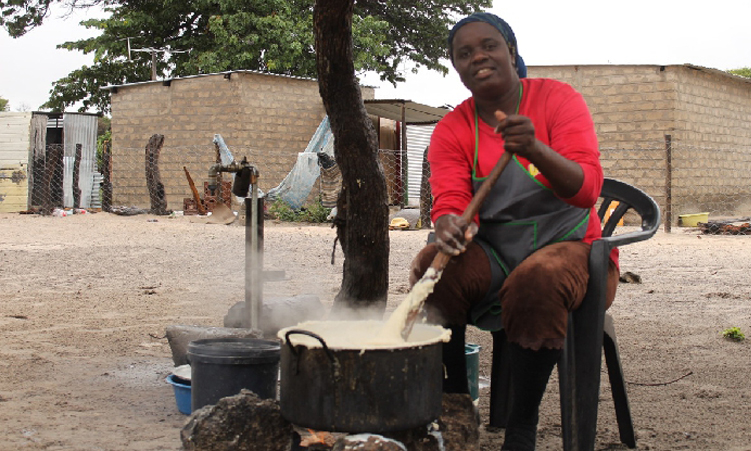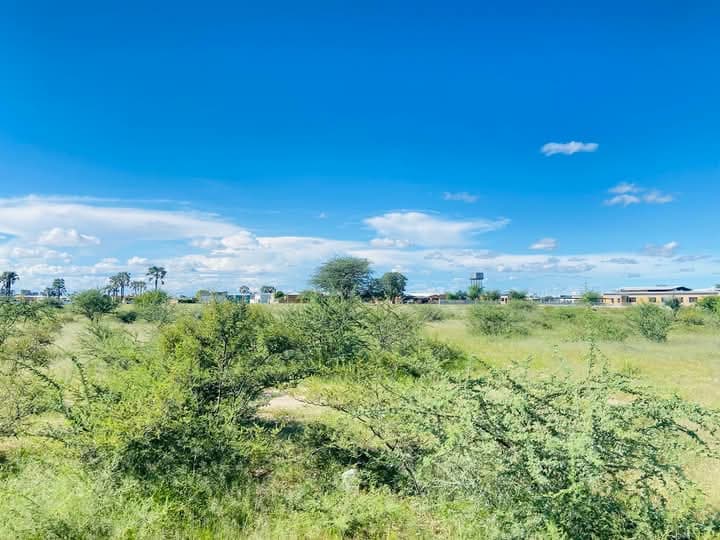…but with optimism the hike will push more innovation
Mother of three Nangula Paulus, who sells fat cakes, pap and cool drinks at the Single Quarters Oshetu Traditional Market, says she will use innovation to lessen the impact of the imminent maize meal price increase on her business.
This comes amid an expected increase in the price of maize meal for consumers, as announced by the Namibian Agronomic Board (NAB) recently.
Paulus’ customers are mainly patrons who buy steamy hot kapana at the braai stands inside the traditional market and add pap and salsa to have a sumptuous meal before they go back to work or for a drinking spree.
“I sell mainly mahangu pap for N$10 a portion but I mix the mahangu with maize meal to get a lighter colour but still retain that unique tangy taste of fermented mahangu.
“I will now look for a cheaper brand of maize meal to blend with the mahangu,” she says, adding that she buys her mahangu within the market, mainly sourced from the north.
On a good day the trader, who has been selling at the market for about 10 years, blends 10kg super refined maize meal into her mahangu for sale to patrons who either come in groups or as individuals.
Another food vendor who operates from the Soweto Market in Katutura, who declined to be identified, says she uses about 20kg of maize meal per day and she will find a way of passing the increase on to her clients.

“While most people come here for a complete meal of pap and relish, I use pap as a conduit to sell meat because it is hard to sell meat on its own, so we use pap to entice patrons to buy the chicken, beef and lamb that we sell,” she says.
While she uses the most favoured sifted maize meal brand to prepare her pap, she scouts supermarkets to find the cheapest outlet.
Although the NAB set a high floor price for Namibian white maize delivered to millers, the end consumers are not expected to bear the full impact of the new price. This is because millers say they might not pass the total percentage increase onto the market, but absorb some of it.
NAB announced two weeks ago that local producers will be paid a floor price of N$7 554,37 per tonne for white maize delivered to millers during the period from 1-14 May, after which the floor price would be reviewed.
This has dropped slightly to N$7 087,51 per tonne for the period from 15-28 May, according to a notice issued by NAB chief executive Fidelis Mwazi on 14 May.
The set floor price is a way of safeguarding producers against fluctuating prices and storage costs they might incur by keeping the maize for longer periods, as millers might not have enough storage space to take large amounts of grain, said Mwazi.
According to NAB spokesperson Loide Uahengo, the floor price for locally produced white maize is high this year compared to N$5 595 for last year because of the high demand for white maize in South Africa, from where Namibia imports most of its maize.
While the floor price set by NAB is for locally produced maize, it is influenced by prices on the South African Futures Exchange, from where Namibia imports the bulk of its white maize for human consumption.
Zambia, the second biggest exporter of maize to Namibia, this year declared a state of emergency and might, therefore, not be expected to export much to Namibia.
According to NAB, Namibia’s total domestic demand is 180 00 tonnes of maize per year and with a local production of about 38 000 tonnes, Namibia is expected to import at least 142 000 tonnes in the 2023/24 season.
“Millers will be expected to put their own markup, pushing the prices up,” Uahengo said.
This will have a domino effect on the price of staple meal.

“If millers push the price up for retailers, the shops will in turn push the price up for households and vendors. Vendors might in turn increase prices for their clients,” she said.
Prices of mealie meal vary in supermarkets, with the sifted Top Score brand costing between N$120 and N$135 for a 10kg packet, while the unsifted brand costs about N$140. A 10kg of mahangu meal, meanwhile, costs an average of N$200.
Bokomo Namibia chief executive officer Hubertus Hamm said the company is obligated to buy their assigned quotas of local maize at the set floor price.
“If we do not do that we would not get an import permit to buy maize from countries like Zambia or South Africa, seeing that the Namibian maize sector is small,” he said.
“This would affect the price of the end product by about 8-12% but as millers we have not planned a price increase per se but will reduce some of the discounts we have and this would change the end price by about 7-8%,” he said.
“We are selling our super refined product at around N$105 for a 10kg bag, customers might end up paying around N$112 or N$115 for a 10kg bag,” he said.
Hamm said while the sector generally expects the price of maize to increase in South Africa in June, it is expected to drop around September/October and by December, millers will be able to give customers more discounts to cushion them.
– email: matthew@namibian.com.na
Stay informed with The Namibian – your source for credible journalism. Get in-depth reporting and opinions for
only N$85 a month. Invest in journalism, invest in democracy –
Subscribe Now!










